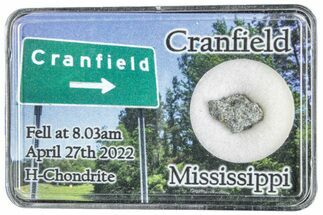1.1" Viñales Chondrite Meteorite (12.7 g) Section - Witnessed Fall!
This is a beautiful 1.1" section (12.7 g) of the Viñales meteorite, which fell in and around the historic Viñales Valley, a UNESCO World Heritage Site, in Pinar del Rio, Cuba on February 1 2019. About 100 kilograms of material have been recovered so far.
The cut face of this specimen shows off the shimmering metallic grains contained within, as well as several shock veins throughout the pale grayish matrix. The natural faces dispaly a nice dark fusion crust.
The cut face of this specimen shows off the shimmering metallic grains contained within, as well as several shock veins throughout the pale grayish matrix. The natural faces dispaly a nice dark fusion crust.
About L6 Chondrite Meteorites
An L6 chondrite meteorite is a type of stony meteorite belonging to the ordinary chondrite group, the most common category of meteorites found on Earth. The "L" designation indicates that it has a relatively low total iron content, typically about 7-11%, with iron present in the form of metal grains and sulfides. The "6" refers to its petrologic type, which signifies the extent of thermal metamorphism it has undergone. As a type 6 meteorite, an L6 chondrite has been extensively heated, resulting in the complete recrystallization of its original components. This process has homogenized its mineral grains and largely obliterated the distinct chondrules (small, spherical mineral grains) that characterize less thermally altered chondrites.
L6 chondrites are composed primarily of silicate minerals like olivine and pyroxene, along with metal grains and sulfides. Their texture is relatively uniform due to the high degree of thermal metamorphism, giving them a more consistent appearance compared to less processed meteorites. Visually, they are often gray to brown in color and may display a smooth fusion crust, formed as the outer surface melted during their fiery entry into Earth's atmosphere.
The L chondrite group is thought to originate from a specific parent body in the asteroid belt that underwent a significant collisional event. This impact likely ejected vast amounts of L chondritic material into space, leading to the high prevalence of L chondrites discovered on Earth. It is believed this collision event happened approximately 470 million years ago.
An L6 chondrite meteorite is a type of stony meteorite belonging to the ordinary chondrite group, the most common category of meteorites found on Earth. The "L" designation indicates that it has a relatively low total iron content, typically about 7-11%, with iron present in the form of metal grains and sulfides. The "6" refers to its petrologic type, which signifies the extent of thermal metamorphism it has undergone. As a type 6 meteorite, an L6 chondrite has been extensively heated, resulting in the complete recrystallization of its original components. This process has homogenized its mineral grains and largely obliterated the distinct chondrules (small, spherical mineral grains) that characterize less thermally altered chondrites.
L6 chondrites are composed primarily of silicate minerals like olivine and pyroxene, along with metal grains and sulfides. Their texture is relatively uniform due to the high degree of thermal metamorphism, giving them a more consistent appearance compared to less processed meteorites. Visually, they are often gray to brown in color and may display a smooth fusion crust, formed as the outer surface melted during their fiery entry into Earth's atmosphere.
The L chondrite group is thought to originate from a specific parent body in the asteroid belt that underwent a significant collisional event. This impact likely ejected vast amounts of L chondritic material into space, leading to the high prevalence of L chondrites discovered on Earth. It is believed this collision event happened approximately 470 million years ago.
$195
TYPE
L6 Chondrite
LOCATION
Pinar del Rio, Cuba
SIZE
1.1 x 1.0 x .55", 12.7 grams
CATEGORY
ITEM
#266002
 Reviews
Reviews










